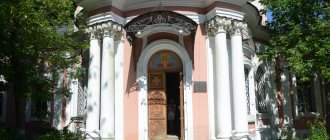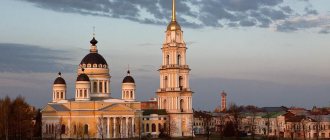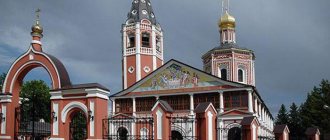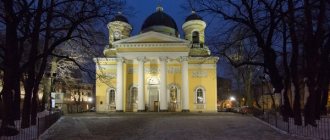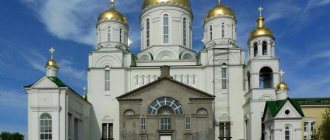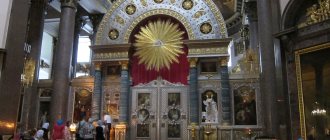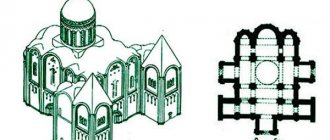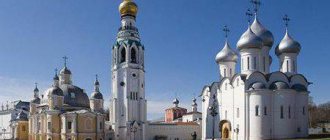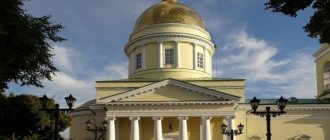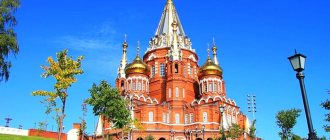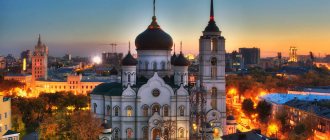Catherine's Cathedral in Pushkin (Russia) - description, history, location. Exact address and website. Tourist reviews, photos and videos.
- May tours
to Russia - Last minute tours
to Russia
1/
10
- Catherine's Cathedral in Pushkin
In the very center of the pompous suburb of St. Petersburg - Pushkin there is a wonderful temple. His name is associated with the name of St. Catherine, one of the patrons of the royal Romanov family. This temple, like a Phoenix bird, has risen from the ruins and again delights with its harmonious and majestic beauty. There is an interesting museum in its basement. Coming to Tsarskoe Selo, it is worth taking a stroll not only through the luxurious palaces and lyceum where the great poet studied, but also to look into the cozy city center, which is decorated with the Catherine Cathedral. It is located right in the middle - between the Alexander Palace and the Tsarskoye Selo railway station.
History of the temple
Catherine's Cathedral in Pushkin was built on the site of the destroyed old Tsarskoye Selo church, dedicated to St. Catherine, originally from Alexandria. At the beginning of the 30s of the XIX century. Emperor Nicholas I issued a decree on the founding of a temple in Tsarskoe Selo in honor of Catherine of Alexandria, the Christian Great Martyr. The construction of the temple was carried out with money allocated by the imperial cabinet.
The consecration of the new temple was carried out by the emperor's confessor, Protopresbyter N.V. Muzovsky in November 1840. Emperor Nicholas I and Tsarevich Alexander were present at the solemn ceremony. In subsequent years, the improvement of the temple and the temple area was constantly carried out. The landscaping of the area around the church was carried out under the guidance of master gardener F.F. Lyamin. According to his design, 12 paths leading to the temple were made.
Trees from Holland planted around the church decorated the cathedral square. The fire of 1862 that occurred in Apraksin Dvor also affected the cathedral located nearby. Particularly severe damage was caused to the bell, on which a large crack appeared from the fire. The gilding was damaged, which eventually caused rust to appear. In mid-1874, temple servants reported a cracked bell and filed a petition to replace it.
A year later, a new bell was cast, which was larger than the old one. For the dome, architect A. Vidov designed a wooden bell tower. A major renovation of the building began in the spring of 1890. There was a free parochial school at the church. After the October Revolution, the number of parishioners visiting the cathedral greatly decreased. Since the fall of 1916, the cathedral service was conducted by Archpriest of the Russian Orthodox Church John, and in October 1917 he was tragically killed.
He was remembered by parishioners as the organizer of a religious procession, calling together with other priests to stop internecine wars. The priests of the temple and parishioners insisted on the burial of Archpriest I. Kochurov in the cathedral tomb.
Over the next 10 years, processions of atheists were held around the church, trying to stop the singing of church ministers. At the beginning of the 30s. XX century The first decrees appeared on the closure of the temple. The rector of the cathedral during this period was Archpriest F. Zabelin, who was relieved of his post in 1936. A year later, the temple, surrounded by a wooden fence, began to be dismantled. The rich altar partitions were destroyed, most of the icons were burned in the basement oven.
Iconostases and church utensils were removed from the temple, and the roof of the cathedral was demolished. The remains of the building were blown up on June 10, 1939. 20 years later, a monument to V.I. Lenin was erected on the site of the cathedral, which was subsequently demolished by unknown persons in April 2004.
The restoration of the cathedral and its shrines began in 1994 and was associated with the canonization of Archpriest I. Kochurov, which took place at the Council of Bishops of the Russian Orthodox Church. During the same period, an 8-pointed cross made of wood was erected on the site of the demolished temple. Its height was 7 m. Later, the old cross was replaced with a new one, made by a monk of the Solovetsky Monastery. The temple was restored with donations from parishioners, sponsors, and residents of nearby houses.
History[edit]
1835—1917
The Tsarskoye Selo City Cathedral of the Holy Great Martyr Catherine was founded in 1835 on the orders of Nicholas I. Construction was carried out according to plan and under the supervision of the architect K. A. Ton. Funds for the construction were allocated by His Majesty's Cabinet.
The consecration of the cathedral took place on November 24 (December 6), 1840, by the emperor's confessor, Protopresbyter Nikolai Muzovsky, in the presence of Nicholas I himself and Tsarevich Alexander Nikolaevich. The cathedral was initially part of the diocesan department, and in the same year the clergy of the Znamenskaya Church was transferred to it with all salaries.
Catherine's Cathedral on a postcard from the early 20th century
The clergy, transferred in 1841 to the cathedral from the Church of the Sign, consisted of an archpriest, a clergyman, two priests, a deacon, two sextons and sextons. In 1875, the vacancy of one sexton was abolished.
Throughout 1842, landscaping work was carried out on the temple square under the leadership of the garden master Fyodor Fedorovich Lyamin. 12 paths were built, converging towards the cathedral. 200 bluish poplars brought from Holland were also planted on the square.
The cathedral was damaged by a fire in the wooden Gostiny Dvor that occurred in 1862. The most significant damage was to the gilding of the domes. In 1865, due to rust, the domes of the cathedral were painted with kronhelm, and in 1869 - with yellow paint, leaving the lower four rows, which retained the gilding.
On June 15 (27), 1874, the clergy of the Catherine Cathedral turned to the city manager with a request to recast the cracked bell and create a special niche for it in the arch above the western facade. On October 11 (23), the bell was removed and in 1875 it was recast with increasing weight. In May of the same year, the priests of the cathedral turned to the city manager with a request to build a temporary wooden bell tower for the bell. In 1876, according to the design of architect A.F. Vidov, a temporary wooden bell tower was built in the southwestern part of Cathedral Square, not far from the main entrance of the cathedral. In 1889, the Lenten bell was raised to its original place without any changes to the facade. In 1910, the clergy of the Catherine Cathedral turned to the city authorities with a request to add “a columned bell tower, corresponding to the beauty of the temple, the construction of which would serve to commemorate the 200th anniversary of the founding of Tsarskoye Selo.” However, the bell tower was not built.
In April 1890, for the 50th anniversary, the largest renovation of the cathedral began, ending in November.
At the cathedral, in a two-story stone house on Kolpinskaya Street, the Catherine Parish School was located. At the beginning of the 20th century, about 180 students studied free of charge at the school.
Attached to the temple was the chapel of the Holy Blessed Prince Alexander Nevsky in the nearby Gostiny Dvor (built in 1862-1864).
1917—1939
In 1917, the number of parishioners in the cathedral sharply decreased: “The rector of the Catherine Cathedral in Tsarskoe Selo, Archpriest N. Smirnov, notes that in his church during one festive all-night vigil there was only one pilgrim.”
From November 1916 until his death on October 31 (November 13), 1917, Archpriest John Kochurov served as the second priest in the cathedral. At the end of October 1917, Tsarskoe Selo became the site of an armed conflict between Bolshevik armed forces and Cossack troops under the command of General Pyotr Krasnov, who remained loyal to the Provisional Government. On October 30 (November 12), 1917, during the artillery shelling of Tsarskoe Selo by the Bolsheviks, Father John with other clergy of the cathedral participated in a procession with special prayers for “an end to internecine warfare.” On October 31 (November 13), 1917, Bolshevik detachments entered Tsarskoe Selo and the priests leading the religious procession were arrested; Father John was dragged to the Tsarskoe Selo airfield and there he was brutally killed in front of his high school student son. At the request of the parishioners, on November 4 (17), Father John was buried in the cathedral tomb. On November 24 (December 7), the patronal feast of the cathedral, Metropolitan of Petrograd Veniamin (Kazansky) celebrated the liturgy in the cathedral and presented the parish with the icon of the Mother of God “Consolation in Sorrows and Sorrows.”
Catherine's Cathedral after the explosion. 1939
In the 1920s and 1930s, the authorities often organized “atheistic processions” around the cathedral, with red flags and songs, especially on church holidays, on Easter, when an Easter procession took place around the cathedral. The processions were organized by the Komsomol; Komsomol members tried to shout out the church singing and the ringing of bells with revolutionary songs. The first “orders” to close the temple were registered in 1934. The requirements appeared before 1937.
On July 10, 1937, the architectural and planning department of the Leningrad City Council ordered the Detskoselsky district executive committee to gild the domes of the cathedral, but in August the order was canceled.
On March 12, 1938, the rector of the cathedral, Archpriest Theodore Zabelin, was relieved of this position, and on April 27, the twenty of the cathedral filed a petition with Metropolitan Alexy (Simansky) of Leningrad to send a new priest to the Catherine Cathedral, but received a verbal answer: “There are no priests, there is no one to send, and We’ll have to surrender the cathedral.” On May 11, the twenty initiated the procedure for handing over the property of the cathedral. On June 1, the presidium of the Pushkin District Council filed a petition with the presidium of the Leningrad City Council to close the cathedral and demolish it “as not representing cultural value.” The request was granted. By decree of the Presidium of the Leningrad Oblast Executive Committee of July 11, 1938, Catherine's Cathedral was closed. A special commission organized on October 24, after examining the building, proposed using the building for a theater and cinema, and the basement as a gas shelter.
In May 1939, the cathedral was surrounded by a solid plank fence. Workers removed the roof, church furniture, iconostases and paintings were taken away. The icons were stabbed with axes and dumped in a heap, and then burned in the basement, in the temple ovens.
On June 10, 1939, at 5:30 a.m., St. Catherine's Cathedral was blown up. The blasting work was led by mining engineer Nielsen.
Almost immediately, projects for the improvement of the former square appeared: it was proposed to install a monument to Alexander Pushkin, a swimming pool with fountains and flower edging, children’s playgrounds; the creation of a large green area, a park and architectural ensemble dedicated to the work of Pushkin, “his poems, fairy tales, poems, tragedies and stories”; transform the square into a “pantheon of great people of the pre-revolutionary era.” But the plans could not be implemented.
In 1947, in Berlin, art critic Anatoly Kuchumov, who was part of the commission for the liquidation of the cathedral, discovered an icon from the cathedral “The Last Supper” by Fyodor Bruni in a warehouse in the eastern harbor on the Spree.
By 1950, the mountain of remains of the Catherine Cathedral gradually settled and turned into an ordinary city square. On April 22, 1960, on the crest of new anti-church persecutions in the USSR, which went down in history as “Khrushchev’s”, a monument to Lenin was unveiled on the site of the cathedral.
Restoration and Sanctification (2010)
In connection with the canonization of Archpriest John Kochurov by the Council of Bishops of the Russian Orthodox Church on December 4, 1994, on February 5, 1995, a seven-meter eight-pointed wooden cross was erected on the former Cathedral Square, next to the place where the Catherine Cathedral was located before its destruction. For the installation of the cross, at the suggestion of the district prosecutor, an administrative case was opened against Archpriest Gennady Zverev, he was fined 388 thousand rubles, and ordered to dismantle the cross. In turn, Pushkin’s believers stated that they were ready to bear all the costs of dismantling the monument to Lenin. In April of the same year, the St. Petersburg City Hall commission decided to dismantle the monument to Lenin in Pushkin (as well as at the Warsaw Station).
In 2000, the chief architect of the Tsarskoye Selo Museum, Kedrinsky, completed a preliminary design for the reconstruction of the main square, which involved the restoration of the Catherine Cathedral in two stages.
In 2001, the foundation of the cathedral was classified by KGIOP as an identified object of cultural heritage of the peoples of Russia.
On November 3, 2003, a new wooden cross made on the Solovetsky Islands by monk George was installed and consecrated on Cathedral Square. It was donated to the Tsarskoye Selo deanery by the charitable foundation “Revival of architectural monuments of the Russian North.”
The cathedral after gilding the domes (2014)
On June 3, 2006, an expedition from the Institute of the History of Material Culture of the Russian Academy of Sciences began large-scale archaeological excavations of the foundation. On August 4, KGIOP announced the possible restoration of the temple, noting the need to conserve the discovered foundation and continue research work in the archives. On August 25, archaeological excavations of the cathedral’s foundation were completed, during which elements of engineering communications, remains of architectural details and church utensils were also discovered. On November 1, the foundation of the cathedral was preserved.
On July 20, 2006, the Charitable Foundation “Reconstruction of St. Catherine’s Cathedral in Tsarskoe Selo” was established (registered on October 26). On November 10, the foundation approved a charitable program for the reconstruction of the cathedral. The foundation stone of the temple took place on December 7, 2006. In front of the future altar of the temple there is a memorial sign in the form of a stone, on which is engraved the inscription about the event that took place: “On this place a monument temple will be built as a tribute of deep respect to the selfless and majestic feat of the inhabitants of Tsarskoye Selo, in memory of the tragic days of 1917. (December 7, 2006).”
On February 13, 2007, the Government of St. Petersburg signed a decree on measures to carry out work to preserve the Cathedral of St. Catherine in Tsarskoe Selo. On February 15, the Scientific Council for the Preservation of Cultural Heritage of the Government adopted the concept of recreating the cathedral according to the design of the architect Mikhalychev.
The foundation of the cathedral was reopened on April 7, 2007, then preparation and equipment of the construction site began. On October 16, the foundation of the cathedral was poured.
On November 26, 2008, the Chairman of the Russian Government, Vladimir Putin, signed an order to create an organizing committee to prepare the celebration of the 300th anniversary of the founding of Tsarskoe Selo, the most important element of which will be the reconstruction of the cathedral.
On August 4, 2009, the central chapter was raised onto the temple building, and the next day - four small ones.
On December 7, 2009, the first liturgy was served in the cathedral under construction, and a new ringing of seven bells, which is a copy of the lost one, was consecrated. The bells were installed on the belfry on February 11, 2010.
On June 1, 2010, a mosaic icon of the Holy Great Martyr Catherine was installed on the facade, made by the creative workshop of Ekaterina Ogorodnikova based on a sketch by Mikhalychev.
June 27, 2010 (during the celebrations dedicated to the 300th anniversary of the founding of Tsarskoye Selo), Patriarch Kirill, concelebrated by Metropolitan of St. Petersburg and Ladoga Vladimir, Bishops of Solnechnogorsk Sergius (Chashina), Peterhof Markell (Vetrova), Vyborg Nazariy (Lavrinenko) ) and the clergy of St. Petersburg churches performed the rite of great consecration of the temple.
By January 19, 2014, gilding of all domes was completed.
Architect and exterior decoration of the cathedral
It was decided to revive the Catherine Cathedral in Pushkin according to archival plans. The modern temple was restored according to the design of the architect K. A. Ton, which was developed at the beginning of the 19th century, but appropriate adjustments were made. Previously, archaeological excavations were carried out, during which parts of the foundation, utilities, and church utensils were found.
Initially, one throne was installed in the temple. In the middle of the 19th century. the right (in the name of Prince A. Nevsky of Novgorod) and left (in the name of Constantine the Great and Helena Augusta) aisles were built. The one-story building had a basement, which served as a vestment store, a warehouse for candles, and a crypt for the temporary storage of the deceased.
The altar was made in the shape of a semicircle. On the snow-white walls of the cathedral, arches, bas-reliefs with images of saints and angels were made. The building was crowned with a hipped roof. There were 3 doors leading into the church; additional entrances were made to the altar and basement. In 1883 the interior was painted with white from England containing cobalt, the window frames were restored, and the images were updated.
7 furnaces were also repaired. All work was carried out with the participation of Paramon Parfentyev, an honorary citizen of the city. Above the temple towered a four-meter large bell, which was called the “Sunday bell.” It had a bas-relief depicting Empress Catherine and an ornate inscription. The iconostasis contained icons donated by Nicholas I during the construction of the chapels.
They were painted by artists of that time:
- The icons of the Holy Great Martyr Catherine, Alexandra of Rome and the Last Supper were made by a famous Russian artist of the 19th century. F. Bruni.
- The images on the doors, in front of the throne of the Resurrection of Christ, were painted by Alexei Egorov.
- The symbol of Jesus Christ and the 4 evangelists, local images, belonged to the brush of K. Bryullov.
- There are also copies of “The Crucifixion” by V. Dyck and “The Glory of the Virgin” by P. Veronese from the church of the Great Gatchina Palace, which were donated to the temple in 1850.
A. A. Kedrinsky, the chief architect of the Tsarskoye Selo Nature Reserve, worked on creating a sketch of the modern project. He proposed to restore the architectural ensemble in 2 stages. The first stone for the future foundation was laid on December 7, 2006. In subsequent years, organizational work was carried out, and on August 4, 2009, the central dome of the temple was erected on a decorative drum.
A day later, 4 small chapters were raised. For the first time after many years of inactivity, the Divine Liturgy was celebrated in the cathedral under construction. This happened on December 7, 2009. Catherine's Cathedral in Pushkin received new bells, which were installed on the belfry in 2010, but only in January 2014 were they completely covered with gold.
Architectural ensemble of the cathedral
The temple was built in a pseudo-Byzantine style, in the likeness of Suzdal cathedrals. The height of the building is about 50 m. Up to 2 thousand people can be in the church at the same time. The majestic five-domed temple amazes parishioners and tourists with its beauty. On the upper arches you can see the outlines of angels. The temple entrance is made in the form of a rectangular ledge; on the opposite wall there is an elegant semicircular vault decorating the church. The cathedral domes are mounted on high drums.
The façade on the eastern side of the cathedral is decorated with a mosaic icon. It depicts the face of St. Catherine, made according to a sketch by the artist A. V. Mikhalychev. The basement of the temple is given to the museum of the Tsarskoye Selo deanery, where exhibits discovered during archaeological excavations are presented. In the central part of the museum, a large place is occupied by a model of Tsarskoe Selo as it was in the pre-revolutionary years.
Among the exhibits:
- particles of priestly vestments;
- remains of silver frames from icons;
- copies of crystal chandelier pendants;
- coins of those times.
In total, more than 700 items were found. Particular attention is drawn to the box for the Holy Gifts, a large Crucifix, which were miraculously preserved after the destruction of the church in the storerooms of the Catherine Palace in Tsarskoe Selo.
Church of St. Sergius of Radonezh
Another temple built for the needs of the military is the Temple of Sergius of Radonezh. This saint once blessed Dmitry Donskoy for battle and is especially revered by soldiers. The temple was built for the 2nd Infantry Battalion. The first temple was built in 1557 from wood. Then the church building came into use by the Life Guards. Icons revered by the military that accompanied them on campaigns were kept here. For field services, a folding iconostasis was used.
The 2nd battalion was built a new building on the Sofia parade ground, also named after Sergius of Radonezh. At the beginning of the last century, the altar and bell tower were completed in the church.
After the revolution, the temple was closed and was not used for a long time. The church building was seriously damaged during the war. All that was left of it were ruins. In 1972, driving courses were located in the newly rebuilt building. This is how the temple was used until 2009, when the question of returning the church building was raised. Now the temple has been restored and re-consecrated. Church services are held here.
Interior decoration
The temple interior is in a state of reconstruction, but even now the interior decoration amazes with its grandeur, abundance of light and spacious rooms. The whitewashed walls are without ornament, but the presence of the main colors of the newly erected church, gold and white, reflects all the splendor of the future decoration. There are 3 altars in the altar. The main one is dedicated to the Holy Great Martyr Catherine.
On the left is for the Hieromartyr John of Tsarskoye Selo, on the right is for the holy royal passion-bearers. Pink marble used to frame doorways goes well with primary colors. Gilded architectural details repeat its pre-revolutionary design. The altar partition is white, with gilded details, restored according to old drawings.
Catherine's Cathedral in Pushkin, interior decoration.
The images of the iconostasis are made in the Old Russian style and look great on a golden background, which fits into the overall design of the interior decoration. At the western pillars there is a shrine (cases), at the north-eastern wing - the relics of Archpriest John, at the south-eastern wing - particles of the relics of Catherine of Alexandria.
Church of the Resurrection of Christ in the Catherine Palace
In the palace itself, another house church was built in 1740. The opening was attended by the reigning empress, the heir to the throne and his wife (the future Catherine II). The church was erected according to the plan for the reconstruction of the Catherine Palace.
The new temple is adjacent to the palace. You can enter it through the front rooms. The façade of the church, decorated by the famous Rastrelli, is decorated with a double colonnade: massive columns up to the second floor and lightweight ones on level 3-4. The church is decorated with angels and cherubs. The whole thing is crowned by a roof with five domes.
The inside of the temple is decorated in the Rococo style, with an abundance of artistic elements. The blue walls contrast strongly with the gold of the icons and the altar. The altar contained an altar canopy on eight columns and a six-tiered iconostasis.
After the revolution there was a museum here. The building was heavily damaged during the Great Patriotic War. The temple was looted by the invaders, and the roof was destroyed by a shell. Partial restoration was carried out in 1963, again rebuilding the dome, but the interior and decoration still need restoration.
Shrines and relics of the temple
Before destruction, particularly important shrines included:
- The Ark with the placed finger of St. George the Victorious and part of the Life-Giving Tree, which was donated by Prince Heraclius of Georgia in memory of his deceased sister.
- Icon of Saint Panteleimon the Healer, panagia.
- A reliquary cross in memory of the deceased son of Mrs. Volkova.
- Icon of the Moscow saints from Bishop Philaret.
- A chalice, silver-gilded with images on a copper plate and rhinestones of different colors, transferred from the Ascension Cathedral in Sofia in 1812.
- Silver chalice depicting the icon of the Last Supper.
- A silver ark weighing 7 kg in the shape of a mountain with the tomb of the Savior with holy faces.
- The altar cross on the throne is silver-gilded, with images on a copper plate and rhinestones.
- Icon of the Virgin Mary of Vladimir in a silver-gilded robe.
Revered saints of the modern temple:
- Relics of the clergyman John.
- Relics of Saint Catherine of Alexandria.
- Miraculous copy of the icon of the Mother of God “Consolation in Sorrows and Sorrows” with the signature of Bishop Metropolitan Veniamin.
- List of the icon of the Mother of God "Prodromitissa of Iasi" from the Romanian Orthodox monastery of Prodromo.
Mentors
The names of all the abbots of the cathedral have been preserved in the history of the temple:
| Years of Service | Names |
| 1841-1865 | Priest Theodore Tigodsky |
| 1865-1883 | Senior priest Andrei Vetvenitsky, teacher of the law at the Imperial Gymnasium in Tsarskoe Selo |
| 1883-1893 | Priest Pavel Lamanov |
| 1893-1916 | Senior Priest Afanasy Belyaev, confessor of Nicholas II |
| 1916-1935 | Senior Priest Nikolai Smirnov |
| 1935-1938 | Senior Priest Theodore Zabelin |
From 2009 to the present, senior priest Nikita Zverev has served as rector of the cathedral.
Modern temple servants:
- Archpriest S. Yu. Kalinin.
- Priest V. M. Melkonyan.
- Priest F. Iliovsky.
- Protodeacon V.I. Kryukov.
- Deacon of the cathedral I. A. Arzeikin.
Visiting rules
To get acquainted with the architecture and interior decoration of the church before visiting, you need to check the time. In the cathedral, it is customary to turn off the sound of your mobile device. Men must remove their hats, and women, on the contrary, must enter with their heads covered. Clothing should hide the shoulders and décolleté. It is unacceptable to visit the temple in see-through or open clothing.
You cannot take photographs without the prior consent of the clergy during the service. It is strictly forbidden to carry bladed weapons, piercing and cutting objects, flammable and toxic substances, or visit the cathedral while intoxicated. It is not permissible to take animals with you or enter with food. It is prohibited to touch exhibits, go beyond fences, cause damage, or leave trash in the room.
Patronal holidays
In Pushkin, parishioners of the Catherine Cathedral venerate the saints in whose honor the temple was consecrated and celebrate their patronal feast days:
| date | Patronal festivities |
| February 7 | The main altar was consecrated in honor of St. Catherine of Alexandria |
| July 17th | 2 chapels were consecrated in honor of the holy royal passion-bearers Nicholas II and his family |
| July 11 | Moving feast of the Synaxis of St. Petersburg Saints |
| December 1 | Cathedral of Saints of the Estonian Land |
| October 31 | Repose in the name of the Hieromartyr John |
The main shrine of the temple is the holy relics of the Hieromartyr John, who was shot in 1917 for his faith.
Catherine's Cathedral in Pushkin has 3 ascribed churches:
- Temple chapel of the blessed prince Igor of Kyiv, Chernigov in Tsarskoe Selo.
- Church of the Icon of the Mother of God, located in the city of Pushkino.
- The current Znamenskaya Church.
- The restored church in the Catherine Palace.
Ascribed temples[edit]
- Znamenskaya Church
The court Znamenskaya Church has a rich history. Today, the church has been restored and services are held there every day.
Address:
Pushkin, Sadovaya st., 2a
Telephone:
+7 8 (812) 466 24 90
Email:
- Chapel of Igor of Chernigov
The Chapel of Igor Chernigov is located at the intersection of Moskovskaya and Konyushennaya streets. During the summer, the Divine Liturgy is celebrated regularly on Sundays and holidays.
Interesting facts about the cathedral
Catherine's Cathedral in Pushkin was recreated in the image of a destroyed church that stood on this site a century ago.
The cathedral has 3 altars:
- The main one serves for holding liturgies in the name of St. Catherine of Alexandria.
- The right one is in the name of the holy royal passion-bearers, canonized by the Russian Orthodox Church.
- Left - in the name of the Hieromartyr John of Tsarskoye Selo, Priest Kochurov I.A.
In the fall of 1912, Father Jacob Chervyakovsky baptized the famous Russian scientist and writer Lev Gumilyov in the cathedral.
Since June 2014, the basement of the temple has been turned into a museum of the Tsarskoye Selo deanery. The exhibits include objects found during excavations, portraits of temple servants, various models, materials from the Tsarskoye Selo Museum, and interactive screens with additional information.
Panteleimon Church
On the territory of the city hospital you can find another Orthodox church. This is Panteleimon Church. It is a small one-story building with one dome rising above the yellow walls. The temple is the heir of the hospital church, which worked at the city hospital in Sofia (a neighboring town). When this city became part of Tsarskoye Selo, the local church was moved here.
Initially, this temple was located outside the city on the road to Pavlovsk, but then the city grew in this direction. The church was built back in 1782. The Church of the Holy Great Martyr Panteleimon the Healer is an Orthodox church in the city of Pushkin on the territory of City Hospital No. 38 named after N. A. Semashko.
Information for visitors
Conversations about the sacraments of baptism and weddings are held daily at 16:30. Before the start of the liturgy, half an hour is set aside for the sacrament of confession. Official website of Catherine's Cathedral: soborekaterina-ru. Catherine's Cathedral group on the VKontakte website: club24445808.
Phone numbers you can call to coordinate excursions:
- +7;
- +7.
Tourists visiting Catherine Park cannot pass by the Cathedral in Pushkin. This unique architectural object is closely associated with many historical names and events, which can be learned about within the walls of the museum, located in the lower floors of the church.
